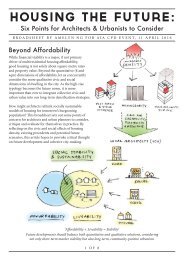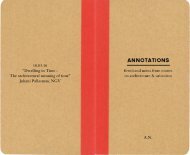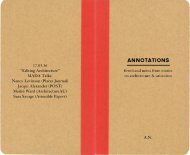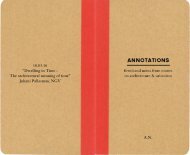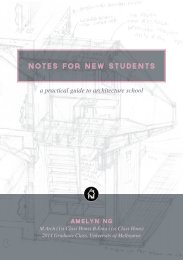Dwelling in Density: Opportunities for Civic Agency and Collective Social Captial
Paper presented at Spaces and Flows Conference 2016, at the University of Philadelphia. All hand-drawn diagrams are original and a copyright of Amelyn Ng.
Paper presented at Spaces and Flows Conference 2016, at the University of Philadelphia. All hand-drawn diagrams are original and a copyright of Amelyn Ng.
You also want an ePaper? Increase the reach of your titles
YUMPU automatically turns print PDFs into web optimized ePapers that Google loves.
<strong>Dwell<strong>in</strong>g</strong> <strong>in</strong> <strong>Density</strong>:<br />
<strong>Opportunities</strong> <strong>for</strong> <strong>Civic</strong> <strong>Agency</strong> <strong>and</strong> <strong>Collective</strong> <strong>Social</strong> Capital<br />
Session Presentation<br />
Human Environments <strong>and</strong> Ecosystemic Effects<br />
Spaces & Flows 7th International Conference 2016<br />
Amelyn Ng<br />
Melbourne, Australia
dwell<strong>in</strong>g <strong>in</strong> density<br />
<strong>Density</strong> prompts new th<strong>in</strong>k<strong>in</strong>g.<br />
Re-evaluat<strong>in</strong>g the f<strong>in</strong>ancialisation of the <strong>in</strong>ner-city urban hous<strong>in</strong>g market & the architecture<br />
profession’s ‘permissive’ relationship with neoliberal real-estate.
Dockl<strong>and</strong>s Drive & Bourke Street, Dockl<strong>and</strong>s, Melbourne<br />
Source: Film Victoria Australia
Southbank, Melbourne<br />
Source: Urban Melbourne
fishermans bend, melbourne<br />
Fishermans Bend, ‘Australia’s Largest Urban Renewal Project’: 485Ha ex-<strong>in</strong>dustrial l<strong>and</strong> to house 80,000 residents by<br />
2050. Source: FBURA Recast Fact Sheet, DELWP, Victorian Plann<strong>in</strong>g Authority Website, April 2015.<br />
Amendments to Plann<strong>in</strong>g Scheme: Interim m<strong>and</strong>atory maximum height controls <strong>for</strong> brownfield site<br />
New residential & employment prec<strong>in</strong>cts to accommodate 80,000 people & support 60,000 new jobs by 2050.<br />
Authentic or token ‘mixed-use’ development? “The next Dockl<strong>and</strong>s”?
Fishermans Bend Urban Renewal- various multi-tower masterplan developmentts<br />
Source: Urban Melbourne.
Fishermans Bend Urban Renewal- various approved schemes<br />
Source: Urban Melbourne.
dwell<strong>in</strong>g <strong>in</strong> density-beyond af<strong>for</strong>dability<br />
Solutions beyond supply to the hous<strong>in</strong>g af<strong>for</strong>dability problem<br />
OPINION<br />
The Conversation By Nicole Gurran, Rob<strong>in</strong> Goodman, Steven Rowley <strong>and</strong> John Daley<br />
Updated Mon 24 Oct 2016, 7:04pm<br />
Treasurer Scott Morrison has outl<strong>in</strong>ed his vision <strong>for</strong> <strong>in</strong>creas<strong>in</strong>g home ownership at a speech to the Urban<br />
Development Institute of Australia.<br />
The Treasurer acknowledged it was hard <strong>for</strong> first home buyers to get <strong>in</strong>to the Australian hous<strong>in</strong>g market <strong>and</strong> suggested a<br />
number of barriers to <strong>in</strong>creas<strong>in</strong>g hous<strong>in</strong>g supply.<br />
We asked an expert panel to analyse these <strong>and</strong> suggest what other ideas they might have <strong>for</strong> eas<strong>in</strong>g the problem.<br />
What the states need to do<br />
The Treasurer's comments about the plann<strong>in</strong>g system are out of date. A decade of state re<strong>for</strong>ms to alleviate supply<br />
constra<strong>in</strong>ts have enabled the <strong>in</strong>ner city apartment boom, <strong>and</strong> generated a steady supply of outer suburban l<strong>and</strong> to build<br />
on.<br />
With hous<strong>in</strong>g construction at record numbers, state plann<strong>in</strong>g systems are clearly able to respond to ris<strong>in</strong>g market<br />
dem<strong>and</strong>. Putt<strong>in</strong>g aside questions about the location <strong>and</strong> quality of new hous<strong>in</strong>g, <strong>in</strong>creased construction hasn't delivered<br />
cheaper homes, nor does the Treasurer seem to want that.<br />
In fact, he spends much of his speech caution<strong>in</strong>g about risks to the hous<strong>in</strong>g market from the removal of negative gear<strong>in</strong>g<br />
or from an over-supply of apartments.<br />
With our hous<strong>in</strong>g system so dependent on the private sector, the real question is how to keep construction runn<strong>in</strong>g when<br />
the market cools.<br />
If Treasurer Morrison is truly concerned about af<strong>for</strong>dability he should also be ask<strong>in</strong>g how to secure af<strong>for</strong>dable homes as<br />
part of new development, without lower<strong>in</strong>g values across the established market.<br />
Provid<strong>in</strong>g <strong>in</strong>centives <strong>for</strong> developers to provide af<strong>for</strong>dable homes is an obvious solution <strong>and</strong> one that the property <strong>in</strong>dustry<br />
itself has been lobby<strong>in</strong>g <strong>for</strong>. This entails government support to drive <strong>in</strong>vestment towards af<strong>for</strong>dable rental hous<strong>in</strong>g <strong>and</strong> to<br />
enable a new range of hous<strong>in</strong>g products such as shared equity <strong>and</strong> low cost home ownership.<br />
At present, only around 2 per cent of new homes are delivered by af<strong>for</strong>dable <strong>and</strong> non profit hous<strong>in</strong>g providers. A larger<br />
af<strong>for</strong>dable hous<strong>in</strong>g sector, assisted by government to draw on <strong>in</strong>novative sources of <strong>in</strong>stitutional f<strong>in</strong>ance, would be able to<br />
susta<strong>in</strong> new hous<strong>in</strong>g construction, irrespective of the market cycle.<br />
The commonwealth should negotiate with states so that <strong>in</strong>frastructure <strong>in</strong>vestment <strong>and</strong> l<strong>and</strong> release is closely l<strong>in</strong>ked to
eyond af<strong>for</strong>dability<br />
Broaden<strong>in</strong>g current discourse on <strong>in</strong>ner-city development beyond quantitative, short-term<br />
market delivery/feasibility, to <strong>in</strong>clude long-term social value & susta<strong>in</strong> rights of the citizen.<br />
“...the city [is] not simply an economic or geographic<br />
phenomenon, but above all, a social complex.<br />
...If first place is given to questions of f<strong>in</strong>ancial remuneration<br />
<strong>and</strong> if no more of the common human factor enters <strong>in</strong>to the<br />
picture than can be en<strong>for</strong>ced by build<strong>in</strong>g codes, then... the<br />
life of the <strong>in</strong>dividual becomes atomised.”<br />
- Sigfried Gideon, ‘Contact Between the Individual & Community’, Architecture You & Me, 1958, p158.
eyond af<strong>for</strong>dability<br />
Broaden<strong>in</strong>g current discourse on <strong>in</strong>ner-city development beyond quantitative, short-term<br />
market delivery/feasibility, to <strong>in</strong>clude long-term social value & susta<strong>in</strong> rights of the citizen.<br />
‘the right to<br />
self-management’<br />
‘the right<br />
to culture’<br />
‘the right<br />
to (public)<br />
services’<br />
‘the right to<br />
identity with<strong>in</strong><br />
difference’<br />
‘Rights of the Citizen’, Lefebvre, Henri, eds. Stuart Elden, Elizabeth Lebas, &<br />
Eleonore Kofman, Henri Lefebvre: key writ<strong>in</strong>gs, New York: Cont<strong>in</strong>uum, 2003, p250-253.
the architect's framework<br />
Navigat<strong>in</strong>g site & time constra<strong>in</strong>ts, types, public & private
civic agency<br />
+<br />
1 2<br />
CIVITAS<br />
agentia
civic agency<br />
Magnette, Paul, Citizenship: The History of an Idea, Colchester: ECPR Press, 2005, p19.<br />
1<br />
CIVITAS<br />
(Lat<strong>in</strong>)<br />
Citizenship, espcially as<br />
impart<strong>in</strong>g shared responsibility,<br />
a common purpose,<br />
<strong>and</strong> sense of community.<br />
Instead of Greek politeia (city is superior to<br />
citizen), Lat<strong>in</strong> first recognises the citizen<br />
(from which ‘city’ & ‘citizenship’ are derived)-<br />
based on k<strong>in</strong>ship not on territory.<br />
“Citizenship is a status of reciprocity”.
civic agency<br />
Onl<strong>in</strong>e Etymology Dictionary, 2016.<br />
Stan<strong>for</strong>d Encyclopedia of Philosophy, 2015.<br />
2<br />
agentia<br />
(Medieval Lat<strong>in</strong>, 1650s)<br />
Active operation.<br />
(Sociology / Philosophy)<br />
The exercise of an agent’s capacity to act <strong>in</strong> a given environment.
agency<br />
Hewson, Mart<strong>in</strong> (2010). “<strong>Agency</strong>”, <strong>in</strong> Encyclopedia of Case Study Research, ed. Albert J. Mills et<br />
al, LA: SAGE Publications, 2010, pp 13-17.<br />
2<br />
agency<br />
Hewson’s Classification:<br />
<strong>in</strong>dividual proxy collective<br />
‘I act on my own<br />
behalf ’<br />
‘Someone else acts on<br />
my behalf ’<br />
‘we act together’
agency<br />
Hewson, Mart<strong>in</strong> (2010). “<strong>Agency</strong>”, <strong>in</strong> Encyclopedia of Case Study Research, ed. Albert J. Mills et<br />
al, LA: SAGE Publications, 2010, pp 13-17.<br />
‘I act on my own<br />
behalf ’<br />
‘Someone else acts on<br />
my behalf ’<br />
‘we act together’
social capital<br />
OECD, ‘What is <strong>Social</strong> Capital?’, OECD Insights: Human Capital, last updated 20 Feb 2007,<br />
https://www.oecd.org/<strong>in</strong>sights/37966934.pdf.<br />
social capital<br />
(OECD, 2007)<br />
“the l<strong>in</strong>ks, shared values <strong>and</strong> underst<strong>and</strong><strong>in</strong>gs <strong>in</strong> society that enable<br />
<strong>in</strong>dividuals <strong>and</strong> groups to trust each other <strong>and</strong> so work together”<br />
(Robert Putnam, “Bowl<strong>in</strong>g Alone: America’s Decl<strong>in</strong><strong>in</strong>g <strong>Social</strong> Capital”, 1995)<br />
“social networks”<br />
= norms of reciprocity<br />
= trust + cooperation<br />
= improved security + trade<br />
“mak<strong>in</strong>g democracy work”
social capital<br />
OECD, ‘What is <strong>Social</strong> Capital?’, OECD Insights: Human Capital, last updated 20 Feb 2007,<br />
https://www.oecd.org/<strong>in</strong>sights/37966934.pdf.<br />
social capital<br />
(OECD, 2007)<br />
“bonds” “bridges” “l<strong>in</strong>kages”
1<br />
common ground<br />
Ground plane as civic <strong>in</strong>terface & catalyst
common ground<br />
“No apartment is an isl<strong>and</strong>”:<br />
Connect<strong>in</strong>g cont<strong>in</strong>guous residential sites & re<strong>in</strong><strong>for</strong>c<strong>in</strong>g sociocultural adacencies<br />
• Conventional multi-residential towers<br />
rema<strong>in</strong> <strong>in</strong>sular to <strong>in</strong>dividual<br />
plots<br />
• ‘Turn<strong>in</strong>g its back to the street’<br />
Impermeability denies public<br />
• engagement & breeds isolation<br />
• Erosion of social capital & ‘neighbour’<br />
Albert Tower, St Kilda Road Southbank<br />
Source: Rothelowman
common ground<br />
“No apartment is an isl<strong>and</strong>”:<br />
Connect<strong>in</strong>g cont<strong>in</strong>guous residential sites & re<strong>in</strong><strong>for</strong>c<strong>in</strong>g sociocultural adacencies<br />
• Conventional multi-residential towers<br />
rema<strong>in</strong> <strong>in</strong>sular to <strong>in</strong>dividual<br />
plots<br />
• ‘Turn<strong>in</strong>g its back to the street’<br />
Impermeability denies public<br />
• engagement & breeds isolation<br />
• Erosion of social capital & ‘neighbour’<br />
My80 Tower, Melbourne CBD<br />
Source: Peter Clarke
common ground<br />
“No apartment is an isl<strong>and</strong>”:<br />
Connect<strong>in</strong>g cont<strong>in</strong>guous residential sites & re<strong>in</strong><strong>for</strong>c<strong>in</strong>g sociocultural adacencies<br />
• Conventional multi-residential towers<br />
rema<strong>in</strong> <strong>in</strong>sular to <strong>in</strong>dividual<br />
plots<br />
• ‘Turn<strong>in</strong>g its back to the street’<br />
Impermeability denies public<br />
• engagement & breeds isolation<br />
• Erosion of social capital & ‘neighbour’<br />
• Potential to democratise through-access<br />
<strong>and</strong> protect urban cont<strong>in</strong>uity<br />
• Establish common ground plane across<br />
multiple private developments:<br />
new procurement model needed<br />
• Permeable social layer at street level<br />
• Implement horizontal ‘setback’ zon<strong>in</strong>g?
common ground<br />
“No apartment is an isl<strong>and</strong>”: Plot Ratio<br />
Source (left): Plot Ratio: A Plan to Combat Congestion <strong>in</strong> London, London County Council, 1957
common ground<br />
“No apartment is an isl<strong>and</strong>”: Planar Consideration of Plot Ratio
common ground<br />
Architectural legibility of civic ground, diversity <strong>and</strong> access
common ground<br />
High-rise homogeneity & <strong>in</strong>sularity: prevail<strong>in</strong>g apartment model<br />
• ‘Locked Lobby’:<br />
developer’s modus oper<strong>and</strong>i<br />
• Gated vertical communities<br />
seen as a typological ‘norm’<br />
• Inert street <strong>in</strong>terfaces<br />
• Monocultural br<strong>and</strong><strong>in</strong>g<br />
• Poor civic utility<br />
My80 Tower, Melbourne CBD<br />
Source: Peter Clarke
common ground<br />
“No apartment is an isl<strong>and</strong>”:<br />
Connect<strong>in</strong>g cont<strong>in</strong>guous residential sites & re<strong>in</strong><strong>for</strong>c<strong>in</strong>g sociocultural adacencies<br />
• ‘Locked Lobby’:<br />
developer’s modus oper<strong>and</strong>i<br />
• Gated vertical communities<br />
seen as a typological ‘norm’<br />
• Inert street <strong>in</strong>terfaces<br />
• Monocultural br<strong>and</strong><strong>in</strong>g<br />
• Poor civic utility<br />
• ‘Open Lobby’: Time-sensitive programm<strong>in</strong>g<br />
• Intelligent, culturally productive shared <strong>in</strong>terfaces<br />
• Programmatic flexibility managed by both body<br />
corporate <strong>and</strong> <strong>in</strong> part by residents<br />
• Policy level change needed <strong>for</strong> large-scale adoption:<br />
Re-evaluate zone overlays, prompt developers/<br />
architects of adjacent sites to negotiate shared space<br />
prior to lodg<strong>in</strong>g of plann<strong>in</strong>g draw<strong>in</strong>gs
HSBC Headquarters by Foster + Partners, Hong Kong - Atrium on Weekday<br />
Source: Foster + Partners
HSBC Headquarters by Foster + Partners, Hong Kong - Atrium on Weekend<br />
Source: Foster + Partners
HSBC Headquarters by Foster + Partners, Hong Kong - Occupy Protests Nov 2011<br />
Photo by Thomas Lee / Bloomberg via Getty. Source: The New Yorker
2<br />
amenity-share<br />
Pool<strong>in</strong>g public & private amenity, reth<strong>in</strong>k<strong>in</strong>g connections
Melbourne CBD Typical apartment amenities<br />
Sources: Elenberg Fraser (above), Rothelowman (below).
amenity-share<br />
Current model of private access to generic amenity assets <strong>in</strong> luxury apartment developments:<br />
Unsusta<strong>in</strong>able duplicates, silo<strong>in</strong>g of social <strong>in</strong>teractions
amenity-share<br />
Best locations (views, solar access) <strong>in</strong> high-density environments are private:<br />
Vertical gradient of real-estate value <strong>and</strong> displacement of street-level desirability casuses<br />
power imbalances between public <strong>and</strong> private, <strong>and</strong> <strong>in</strong>stigate identity-related <strong>in</strong>equality.
amenity-share<br />
Current model of private access to generic amenity assets <strong>in</strong> luxury apartment developments:<br />
Unsusta<strong>in</strong>able duplicates, silo<strong>in</strong>g of social <strong>in</strong>teractions
amenity-share<br />
Redef<strong>in</strong><strong>in</strong>g ‘communal space’: disembedd<strong>in</strong>g amenity & shar<strong>in</strong>g with adjacent sites<br />
Reduc<strong>in</strong>g unnecessary duplication & strengthen<strong>in</strong>g exist<strong>in</strong>g civic <strong>in</strong>frastructure<br />
Public gym, pool, oval, sports facilities<br />
Public parks <strong>and</strong> l<strong>and</strong>scap<strong>in</strong>g<br />
Home-offices & consultancies<br />
Bookable multi-purpose<br />
halls & recreation rooms<br />
Subsidised studio &<br />
workshop spaces<br />
Community legal services<br />
Childcare & education support services
amenity-share<br />
Redef<strong>in</strong><strong>in</strong>g ‘communal space’: disembedd<strong>in</strong>g amenity & shar<strong>in</strong>g with adjacent sites<br />
Reduc<strong>in</strong>g unnecessary duplication & strengthen<strong>in</strong>g exist<strong>in</strong>g civic <strong>in</strong>frastructure
amenity-share<br />
Potential <strong>for</strong> high-rise residential typology to have more horizontal ‘rhizomatic’ relations:<br />
Deleuze, Gilles, <strong>and</strong> Félix Guattari, A thous<strong>and</strong> plateaus: capitalism <strong>and</strong> schizophrenia.<br />
London: Cont<strong>in</strong>uum, 2004.
amenity-share<br />
Potential <strong>for</strong> high-rise residential typology to have more horizontal ‘rhizomatic’ relations:<br />
Image source: epr<strong>in</strong>ts.usq.edu.au.
amenity-share<br />
Potential <strong>for</strong> high-rise residential typology to have more horizontal ‘rhizomatic’ relations:<br />
Programmatic l<strong>in</strong>ks across sites, restructur<strong>in</strong>g vertical hierarchies between public & private.
uild<strong>in</strong>g review<br />
Potential <strong>for</strong> high-rise residential typology to have more horizontal ‘rhizomatic’ relations:<br />
L<strong>in</strong>ked Hybrid, Beij<strong>in</strong>g by Stephen Holl Architects. Source: Archdaily<br />
+<br />
walkable<br />
<strong>in</strong>termediate<br />
connections<br />
programmatic<br />
variation<br />
typological<br />
re<strong>in</strong>vention
uild<strong>in</strong>g review<br />
Potential <strong>for</strong> high-rise residential typology to have more horizontal ‘rhizomatic’ relations:<br />
L<strong>in</strong>ked Hybrid, Beij<strong>in</strong>g by Stephen Holl Architects. Source: Archdaily
uild<strong>in</strong>g review<br />
Potential <strong>for</strong> high-rise residential typology to have more horizontal ‘rhizomatic’ relations:<br />
L<strong>in</strong>ked Hybrid, Beij<strong>in</strong>g by Stephen Holl Architects. Source: Archdaily
uild<strong>in</strong>g review<br />
‘Rhizomatic’ relations not yet autonomous- many unconventional/experimental typologies are<br />
costly <strong>and</strong> thus rely heavily on capitalist (even laissez-faire) development.<br />
L<strong>in</strong>ked Hybrid, Beij<strong>in</strong>g by Stephen Holl Architects. Source: Archdaily<br />
+ -<br />
walkable<br />
<strong>in</strong>termediate<br />
connections<br />
‘<strong>for</strong>tress’ site<br />
s<strong>in</strong>gle-developer<br />
multi-tower<br />
development<br />
programmatic<br />
variation<br />
typological<br />
re<strong>in</strong>vention<br />
private program<br />
private access<br />
Unwalkable ground<br />
plane & scale<br />
imabalance<br />
Poor street-level<br />
density & <strong>in</strong>tensity
uild<strong>in</strong>g review<br />
Potential <strong>for</strong> high-rise residential typology to have more horizontal ‘rhizomatic’ relations:<br />
L<strong>in</strong>ked Hybrid, Beij<strong>in</strong>g by Stephen Holl Architects. Source: Archdaily<br />
-<br />
‘<strong>for</strong>tress’ site<br />
s<strong>in</strong>gle-developer<br />
multi-tower<br />
development<br />
private program<br />
private access<br />
Unwalkable ground<br />
plane & scale<br />
imabalance<br />
Poor street-level<br />
density & <strong>in</strong>tensity
uild<strong>in</strong>g review<br />
Potential <strong>for</strong> high-rise residential typology to have more horizontal ‘rhizomatic’ relations:<br />
L<strong>in</strong>ked Hybrid, Beij<strong>in</strong>g by Stephen Holl Architects. Source: Archdaily
6<br />
self-governance<br />
Gaps <strong>for</strong> community ownership & operation
self-governance<br />
Importance of distributed responsibility amongst occupants <strong>for</strong> mid-to-high density<br />
neighbourhood creation <strong>and</strong> susta<strong>in</strong>able security.
33M by Elenberg Fraser, Melbourne CBD<br />
Source: Peter Clarke (left), Doma<strong>in</strong> (right)
Heller Street Park & Residences by Six Degrees Architects, Brunswick<br />
Source: Patrick Rodgriguez
Heller Street Park & Residences by Six Degrees Architects, Brunswick<br />
Source: Hansen
4<br />
social stam<strong>in</strong>a<br />
Demographic diversity, mixed-dwell<strong>in</strong>g models
demographic diversity<br />
Democratis<strong>in</strong>g urban fabric <strong>and</strong> access to <strong>in</strong>ner-city hous<strong>in</strong>g<br />
Integration over fragmentation <strong>in</strong> zon<strong>in</strong>g controls
demographic diversity<br />
Democratis<strong>in</strong>g urban fabric <strong>and</strong> access to <strong>in</strong>ner-city hous<strong>in</strong>g<br />
Integration over fragmentation <strong>in</strong> zon<strong>in</strong>g controls
demographic diversity<br />
Democratis<strong>in</strong>g urban fabric <strong>and</strong> access to <strong>in</strong>ner-city hous<strong>in</strong>g<br />
Integration over fragmentation <strong>in</strong> zon<strong>in</strong>g controls
eth<strong>in</strong>k<strong>in</strong>g delivery<br />
Commitment to a more equitable property market
Night<strong>in</strong>gale Model <strong>in</strong>stigated by Breathe Architecture, across various <strong>in</strong>ner Melbourne sites<br />
Triple-bottom-l<strong>in</strong>e, architect driven multi-residential development model geared towards owner-occupiers.<br />
Source: Andrew Wuttke
melbourne: night<strong>in</strong>gale model<br />
Triple-bottom-l<strong>in</strong>e “open source” multi-residential development model, architect-driven, geared towards owner-occupiers.<br />
Source: Night<strong>in</strong>gale website.
melbourne: night<strong>in</strong>gale model<br />
Triple-bottom-l<strong>in</strong>e “open source” multi-residential development model, architect-driven, geared towards owner-occupiers.<br />
Source: Night<strong>in</strong>gale website.
First Night<strong>in</strong>gale Project: The Commons, Brunswick by Breathe Architecture<br />
Source: Andrew Wuttke
First Night<strong>in</strong>gale Project: The Commons, Brunswick by Breathe Architecture<br />
Source: Andrew Wuttke
First Night<strong>in</strong>gale Project: The Commons, Brunswick by Breathe Architecture<br />
Source: Andrew Wuttke
First Night<strong>in</strong>gale Project: The Commons, Brunswick by Breathe Architecture<br />
Source: Andrew Wuttke (left), James Geer (right)
melbourne: night<strong>in</strong>gale model<br />
Stag<strong>in</strong>g of architect-led open-source model + ethical <strong>in</strong>vestors + purchaser engagement<br />
Source: Night<strong>in</strong>gale website.<br />
?<br />
1 2 3<br />
4 ?<br />
?<br />
?
eadjust<strong>in</strong>g the architect's framework<br />
Where is civic amenity <strong>in</strong> the Better Apartment St<strong>and</strong>ards?<br />
‘Better Apartments’, DELWP, Victorian Plann<strong>in</strong>g Authority Website, April 2015.
the architect's framework<br />
Detail > Form > Type > Adjacent > Urban > Timescale > Market Behaviour > New Norms<br />
Gifu Kitagata Apartments, SANAA
the architect's framework<br />
Detail > Form > Type > Adjacent > Urban > Timescale > Market Behaviour > New Norms
the architect's framework<br />
Detail > Form > Type > Adjacent > Urban > Timescale > Market Behaviour > New Norms
the architect's framework<br />
Detail > Form > Type > Adjacent > Urban > Timescale > Market Behaviour > New Norms
the architect's framework<br />
Detail > Form > Type > Adjacent > Urban > Timescale > Market Behaviour > New Norms
the architect's framework<br />
Detail > Form > Type > Adjacent > Urban > Timescale > Market Behaviour > New Norms<br />
Determ<strong>in</strong>istic<br />
‘a-h<strong>and</strong>-<strong>in</strong>-everyth<strong>in</strong>g’<br />
Darw<strong>in</strong>istic<br />
‘h<strong>and</strong>s-off ’<br />
Opportunistic<br />
‘h<strong>and</strong>s-on’<br />
Jesko Fezer, <strong>Civic</strong> City CAhier 6: Design In & Aga<strong>in</strong>st the Neoliberal City,<br />
London: Bed<strong>for</strong>d Press, 2013, p24.
next steps<br />
From abstract research to tangible reality: <strong>in</strong>cremental changes to policy, management,<br />
<strong>in</strong>terdiscipl<strong>in</strong>ary prob<strong>in</strong>g required to enable liveable realities to surface at the citizen <strong>in</strong>terface.
next steps<br />
From abstract research to tangible reality: <strong>in</strong>cremental changes to policy, management,<br />
<strong>in</strong>terdiscipl<strong>in</strong>ary prob<strong>in</strong>g required to enable liveable realities to surface at the citizen <strong>in</strong>terface.
next steps<br />
From abstract research to tangible reality: <strong>in</strong>cremental changes to policy, management,<br />
<strong>in</strong>terdiscipl<strong>in</strong>ary prob<strong>in</strong>g required to enable liveable realities to surface at the citizen <strong>in</strong>terface.
next steps<br />
From abstract research to tangible reality: <strong>in</strong>cremental changes to policy, management,<br />
<strong>in</strong>terdiscipl<strong>in</strong>ary prob<strong>in</strong>g required to enable liveable realities to surface at the citizen <strong>in</strong>terface.
next steps<br />
From abstract research to tangible reality: <strong>in</strong>cremental changes to policy, management,<br />
<strong>in</strong>terdiscipl<strong>in</strong>ary prob<strong>in</strong>g required to enable liveable realities to surface at the citizen <strong>in</strong>terface.
next steps<br />
From abstract research to tangible reality: <strong>in</strong>cremental changes to policy, management,<br />
<strong>in</strong>terdiscipl<strong>in</strong>ary prob<strong>in</strong>g required to enable liveable realities to surface at the citizen <strong>in</strong>terface.
next steps<br />
From abstract research to tangible reality: <strong>in</strong>cremental changes to policy, management,<br />
<strong>in</strong>terdiscipl<strong>in</strong>ary prob<strong>in</strong>g required to enable liveable realities to surface at the citizen <strong>in</strong>terface.
next steps<br />
From abstract research to tangible reality: <strong>in</strong>cremental changes to policy, management,<br />
<strong>in</strong>terdiscipl<strong>in</strong>ary prob<strong>in</strong>g required to enable liveable realities to surface at the citizen <strong>in</strong>terface.




